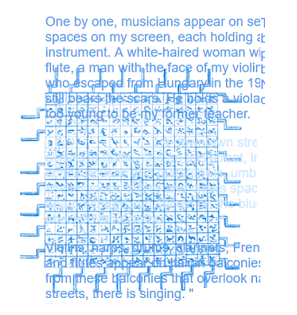Simulating computer-mediated environments that dominated our lives in 2020, in merged with the screen for days, stanzas that move across a four-array structure play unpredictably together -- allowing, if the reader generates several versions, multiple views of the impact of screen-dominated isolation on everyday life. But even with many plays, the viewer is unlikely to see all the variables that are stored in the four arrays that emanate from this narrative engine.
In the past year, computer-mediated systems have furthered education, hosted the arts, and allowed a networked reach to a wider world. As a teacher of art students. I am constantly amazed by what my students express with computer-mediated systems. And the flexibility of the computer screen and the power of algorithmic control allowed me to make this work.
 But in contrast, the sadness that pervades this work is engendered by enforced withdrawal from shared real lives, and merged with the screen for days reflects a need to balance real life.
But in contrast, the sadness that pervades this work is engendered by enforced withdrawal from shared real lives, and merged with the screen for days reflects a need to balance real life.
The dichotomy that this work expresses is keyed when the history of generative literature is referenced in the background by Jonathan Swift's Lagado Engine from Gulliver's Travels. (the drawing probably did not appear until the 1727 third edition of Gulliver's Travels [1]). Although Swift imagined this engine as a satire that predicted where literature, art, and science would go astray centuries later, for years, I have been haunted by the beauty of his illustration.
1. Eric A. Weiss, Anecdotes [Jonathan Swift's Computing Invention] Annals of the History of Computing 7:2, April-June 1985.

